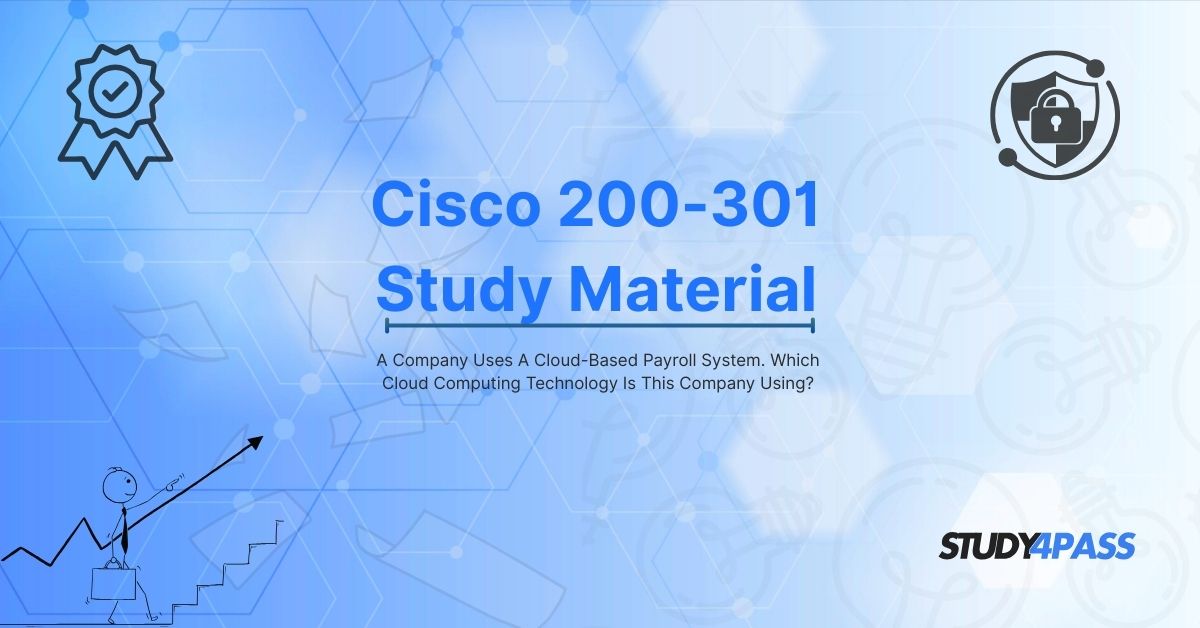Introduction to Cloud-Based Payroll System
In today's digital era, businesses are increasingly adopting cloud-based solutions to streamline operations, enhance efficiency, and reduce costs. One such application is a cloud-based payroll system, which automates salary processing, tax calculations, and compliance reporting. This article explores the cloud computing technology behind such systems, its relevance to CCNA 3 v7 Checkpoint Exam and Cisco 200-301 certification, and how Study4Pass provides essential study materials for IT professionals.
Understanding Cloud-Based Payroll Systems
A cloud-based payroll system allows companies to manage employee salaries, deductions, and tax filings through a remote server instead of on-premise software. This approach offers several advantages:
- Scalability: Easily accommodates business growth.
- Cost-Efficiency: Reduces hardware and maintenance expenses.
- Accessibility: Enables remote payroll processing from any location.
- Security: Cloud providers implement robust encryption and compliance measures.
Which Cloud Computing Technology Is Used?
The company in question likely utilizes Software-as-a-Service (SaaS) for its payroll system. SaaS is a cloud computing model where applications are hosted by a third-party provider and delivered over the internet. Examples of SaaS payroll solutions include:
- ADP Workforce Now
- Gusto
- Paychex Flex
These platforms eliminate the need for in-house servers, automatic updates, and ensure compliance with tax laws.
Connection to CCNA 3 v7 Checkpoint Exam & Cisco 200-301 Certification
Understanding cloud-based payroll systems is crucial for IT professionals, especially those pursuing Cisco certifications like CCNA 200-301. The exam covers:
- Cloud Computing Models (IaaS, PaaS, SaaS)
- Network Security in Cloud Environments
- Virtualization Technologies
Since payroll systems rely on SaaS, networking professionals must ensure secure data transmission, proper firewall configurations, and VPN access for remote employees.
How Study4Pass Supports Your Certification Journey?
For aspiring IT professionals, Study4Pass offers comprehensive study materials, including:
- CCNA 3 v7 Checkpoint Exam Guides
- Cisco 200-301 Practice Tests
- Detailed Cloud Computing Tutorials
Unlike other platforms, Study4Pass provides up-to-date, exam-focused content that helps candidates grasp complex networking and cloud concepts efficiently.
Final Words
A cloud-based payroll system powered by SaaS enhances business efficiency while reducing operational burdens. For IT professionals, mastering cloud technologies is essential, particularly for Cisco 200-301 certification. By leveraging Study4Pass’s high-quality study materials, candidates can gain the expertise needed to excel in cloud networking and beyond.
For the best exam preparation resources, visit Study4Pass today!
Special Discount: Offer Valid For Limited Time “Cisco CCNA 200-301 Practice Test”
Actual exam question from Cisco's 200-301 Study Guide.
Sample Questions for Cisco Cisco 200-301 Certification
1. Which of the following best describes the cloud deployment model used by a company that accesses a payroll system hosted by a third-party provider?
A) Private Cloud
B) Hybrid Cloud
C) Public Cloud
D) Community Cloud
2. A cloud-based payroll system allows employees to access their pay stubs online. Which key cloud computing feature does this demonstrate?
A) Resource Pooling
B) On-Demand Self-Service
C) Rapid Elasticity
D) Measured Service
3. Which of the following is a benefit of using a cloud-based payroll system compared to an on-premise solution?
A) Higher upfront costs
B) Requires in-house IT maintenance
C) Scalability based on demand
D) Limited remote access
4. If a company uses a cloud payroll system but also maintains some HR functions on local servers, what type of cloud deployment model is this?
A) Public Cloud
B) Private Cloud
C) Hybrid Cloud
D) Multi-Cloud
5. Which cloud computing characteristic ensures that the payroll system is available to employees from any location with internet access?
A) Broad Network Access
B) Virtualization
C) High Availability
D) Fault Tolerance


